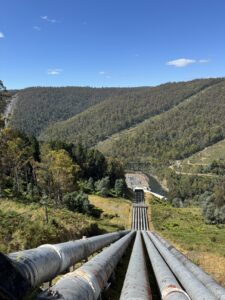
Hydro Tasmania has just posted its worst financial result in recent memory, but you’d have to read between the lines to understand just how serious the situation really is.
When Hydro Tasmania’s 2024-25 Annual Report landed, the headline might have seemed almost routine for a drought year: profit down due to low rainfall. But scratch beneath the surface, and what emerges is a picture of a once-mighty enterprise in genuine financial distress.
The stark reality is, Hydro Tasmania’s profit before fair value adjustments and tax collapsed from $193.7 million to just $7.5 million – a staggering 96% decline. To put that in perspective, the company essentially broke even on its operations after a century of generating reliable returns for Tasmanians.
This isn’t just a bad year. It’s the second consecutive record dry year, described by the company itself as “the biggest multi-year drought in recorded history”. And while management presents this as an unfortunate weather event, it may actually signal something far more troubling, that climate change has fundamentally altered the hydrology that the entire business depends upon.
The impact on Tasmanians is immediate and material. Dividends to the State Government fell to just $4.7 million to be paid in FY2025–26. This serious decline is from a company that in better years returns well over $100 million to help fund schools, hospitals, and infrastructure. At a time when Tasmania is grappling with record deficits and spiralling debt, losing this revenue stream couldn’t come at a worse moment, putting another dent in the Treasurer’s forward projections in this week’s budget. When State government coffers are in such desperate need of more own source revenue the reverse is occurring with returns from Hydro Tasmania.
Here’s where things get really concerning. While the company reported an after-tax profit of $335 million, this figure is almost entirely made up of accounting adjustments rather than actual operational performance. The profit included $96 million in net fair value gains on financial derivatives and a whopping $380 million in asset revaluations.
To re-iterate, the company revalued its assets upward by $380 million during its worst financial year in recent history. The same assets that just generated virtually zero profit were somehow deemed to be worth substantially more. This raises serious questions about valuation methodology and whether asset values reflect genuine earning capacity. One of the major determinants of the value of generation assets is how much they are able to produce, which in turn depends on inflows. In the 2024/25 year the assumed annual generation volume was revised downwards to 8,689 GWh from 8,900 GWh. Yet the value rose. Perhaps future electricity prices were estimated to be higher? To get this into perspective, inflows during the last 2 years have been around 6,200 GWh and 6,700 GWh respectively, reflecting the current drought. Without a significant return to the good old days the value of Hydro’s generation assets can only head in one direction – downwards -affecting not only future profits but the level of borrowings needed to continue on its current path.
Even more troubling, Hydro paid a $122 million dividend when underlying operational profit was only $7.5 million as dividend payments are based on the prior year profits. That means the company paid out more than 16 times its current year earnings. How? By borrowing money and counting unrealized gains as profit. This is the corporate equivalent of spending your home equity thinking you’ve earned it – it works until it doesn’t. Paying such a high proportion of profits as dividends for a capital-intensive business with aging assets in need of maintenance, was a strategy always fraught with risks. Any doubts about this were banished by the 2024/25 year.
The debt story is equally alarming. Net debt climbed to $1,023 million, with interest-bearing liabilities increasing 28% to over $1 billion. Meanwhile, finance expenses hit $82.5 million – more than 11 times the underlying profit.
The company’s cash flow tells the real story. Operating cash flow fell 41% to $143.5 million while capital expenditure reached $284 million. The business isn’t generating enough cash from operations to fund its capital program, let alone pay dividends. Instead, it borrowed a net $234.5 million from Tascorp – effectively borrowing to pay the dividend to government.
This isn’t financially sustainable. You can’t indefinitely borrow money to pay dividends and call it success.
The operational metrics are just as concerning. Hydro generation fell 15% to 6,343 GWh, down 23% over two years. The company’s generation load factor collapsed to 34%, meaning its expensive infrastructure is sitting idle two-thirds of the time.
To protect water storages, the company imported a record 2,458 GWh via Basslink (a net import of 1,910 GWh) and ran its expensive gas-fired Tamar Valley Power Station more frequently. This strategy preserved water but destroyed profitability, exposing a fundamental tension in the business model – the trade-off between energy security and profits.
As part of the Message from the Chair contained in the Annual Report, he noted that “Tasmania’s demand for power is growing”. Actually, Tasmania’s consumption of electricity as recorded by National Electricity Market (NEM) fell in the 2024/25 year compared to the previous year. The fall has continued . In the first quarter of the 2025/26 year, consumption is down 9 per cent compared to the equivalent period a year earlier. It shouldn’t be too much to expect the Chair of such a significant public entity to give a more nuanced view of what happening in the electricity space than a misleading throw-away line from the media department.
No doubt the decline in consumptions is due to problems with major industrials, but given they are such significant part of Hydro’s business surely we deserve a full explanation.
The current comfortable storage levels are in no small part due to a drop in consumption. But you’d never know that from reading the Annual Report.
Just as concerning is that despite this financial crisis, Hydro Tasmania is proceeding with two massive capital projects: the Tarraleah redevelopment and Tasmania’s first pumped hydro facility at Cethana.
The annual report provides virtually no financial detail about either project. No total cost estimates. No expected returns. No risk analysis. Just reassurances that they’ll “only proceed if the business cases stack up. “We do know that Tarraleah is already experiencing delays, failing to meet milestones under its federal grant funding agreement. And we know the company is committing to these mega-projects while barely making a profit and carrying over $1 billion in debt. Tarraleah alone is likely to more than double the debt burden, with only a modest increase in output. But as we are told the efficiency gains will be worth it, a story unfortunately eerily similar to the justification for Basslink.
The question every Tasmanian should be asking: is now really the time to bet the farm on expensive new infrastructure when the core business is in such a challenging position?
Adding to concerns about strategic direction, the company saw three directors and two CEOs depart during the year. The new CEO, Rachel Watson, faces an unenviable task of turning around a business whose fundamental premise – reliable rainfall – may have permanently changed.
This is where we need to get brutally honest. Climate scientists have been warning for years that southern Tasmania would face more frequent and severe droughts. Two consecutive “record” dry years might not be an aberration – they might be the new normal.
Yet the annual report treats climate change as a risk factor to be managed, not an existential threat to the business model. There’s no disclosure of climate scenario modelling, no stress testing of what happens if dry conditions persist for five or ten years, no articulated strategy for operating in a fundamentally different hydrological environment.
The company’s “Towards Net Zero Action Plan” focuses on reducing emissions, not on adapting to climate impacts. This is like rearranging deck chairs while ignoring the iceberg.
The situation demands urgent action. Hydro Tasmania needs to stabilise their financial position, borrowing to pay dividends is unsustainable. The company really needs to conserve cash and focus on debt reduction.
Tasmanians deserve full financial details on Tarraleah and Cethana, including total costs, funding sources, and expected returns. Major capital commitments require public scrutiny.
Hydro Tasmania must model various climate scenarios and articulate how the business remains viable under each. If this has been done, the results need to be available to the owners, the people of Tasmania. If the current business model is broken, we need to know now, not in five years.
Hydro Tasmania’s 2024-25 results aren’t just disappointing for the company but for the owners – they’re a warning sign. A company that has powered Tasmania for over a century delivered essentially zero profit, borrowed heavily to pay dividends, and is proceeding with billion-dollar projects while its core business faces unprecedented challenges.
The drought might end this year. But what happens when the next one arrives? And the one after that? Tasmanians need answers and transparency. And we need those answers before we commit to massive new capital projects that could saddle Tasmanians with debt for decades while the wells – and the profits – run dry.

